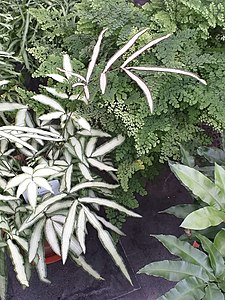en
names in breadcrumbs


Young leaves of young plants of Pteris multifida may key to P . cretica because only the terminal pinnae may be decurrent on the rachis as in P . cretica . Juveniles of P . multifida can be separated by proximal pinnae with long-attenuate apices and thinner-textured leaves than P . cretica . Juveniles of P . cretica have proximal pinnae with acute to blunt or nearly rounded apices and thicker-textured leaves.

Pteris cretica, the Cretan brake,[1] ribbon fern,[2] or Cretan brake fern, is a species of evergreen fern in the family Pteridaceae, native to Europe, Asia and Africa.
The fern grows to 75 cm (30 in) tall by 60 cm (24 in) broad. It has arching pinnate fronds each bearing up to five pinnae.[3][4]
Pteris cretica is cultivated widely by plant nurseries. It is used in gardens in the ground and as a potted plant, and as a houseplant. The variety with variegated foliage, Pteris cretica var. albolineata, is also widely used, brightening shade gardens.
Both types thrive year round outdoors in subtropical climates, such as California. With a minimum temperature of 2 °C (36 °F), both require protection from frost, though the species is hardier and can be grown outdoors during the summer months in cold climates.[3]
The species,[5] and the variety P. cretica var. albolineata (syn. P. nipponica),[6] have both gained the Royal Horticultural Society's Award of Garden Merit.[7]
A relictual presence is certificated in the Italian peninsula Lazio (Ponte Terra gorge, San Vittorino, Rome).
 Pteris cretica 'Albolineata'. Vegetative leaves and sporophylls (upper, linear).
Pteris cretica 'Albolineata'. Vegetative leaves and sporophylls (upper, linear). Pteris cretica, the Cretan brake, ribbon fern, or Cretan brake fern, is a species of evergreen fern in the family Pteridaceae, native to Europe, Asia and Africa.